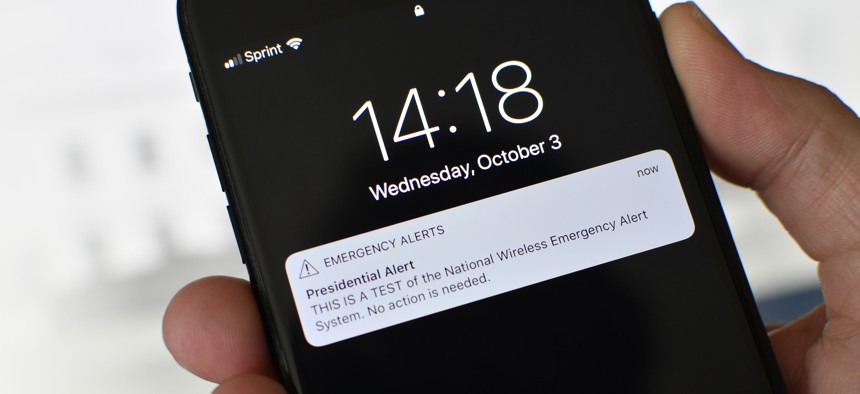State, Local Agencies to Test Geographic Accuracy of Emergency Alerts

Presidential alert is displayed on the screen of an iPhone as the Wireless Emergency Alert (WEA) system conducted in a nationwide test in October 2018. Bastiaan Slabbers/NurPhoto via Getty Images
Amid ongoing concerns from local leaders about the system’s reliability, the FCC will evaluate the accuracy, reliability and speed of Wireless Emergency Alert delivery.
Federal Communications Commission Chairwoman Jessica Rosenworcel announced the commission has for the first time partnered with 42 state and local government agencies to test the geographic accuracy of Wireless Emergency Alerts (WEAs) during local tests later this month.
The testing is planned for Sept. 12 and 13, with the local agencies set to send an alert to the public in a targeted area of its choice at a designated time. The FCC said this round of tests will assess how geographically accurate the alerts are and analyze other factors like reliability and speed.
In a statement, Rosenworcel said the tests come as “emergency managers tell us that they need more information on the geographic accuracy of these alerts in order to use them with confidence.”
An order from the FCC’s Public Safety and Homeland Security Bureau said WEAs have become an “essential part of America’s emergency preparedness,” and carrying out these tests will help improve the alert system and give the public more insight into how it works. The FCC also sent letters to AT&T, T-Mobile and Verizon to ask for detailed feedback on the performance of this test on their networks.
The bureau warned that it has heard reports that some emergency management agencies decline to use WEAs because they do not have confidence in the technology. That was especially prevalent during the Marshall fire in Boulder, Colorado, when local officials declined to use an WEA, and many residents did not receive a timely alert to evacuate.
That incident prompted Colorado Sens. John Hickenlooper and Michael Bennet to write to Rosenworcel urging the FCC to ensure the WEA system is more reliable, as “concerns about the geographic accuracy, delivery, or reliability of WEAs have hampered confidence in the WEA system and impacted its adoption,” the pair wrote.
The FCC tested WEAs last year for timeliness and reliability in partnership with 11 agencies at various levels of government. A report issued after that test found that almost 90% of intended recipients received the test alert, while T-Mobile, AT&T and Verizon reported that the test traversed their network infrastructure from the alert gateway to cell site in approximately 36, 41 and 55 seconds, respectively.
The Federal Emergency Management Agency has warned previously about the security of emergency alerts, cautioning in a security advisory that the equipment used to send the alerts could be vulnerable to bad actors. The most notable instance of emergency alerts going wrong was in 2018, when a state government employee in Hawaii accidentally triggered an emergency alert warning of a ballistic missile during a training exercise.






